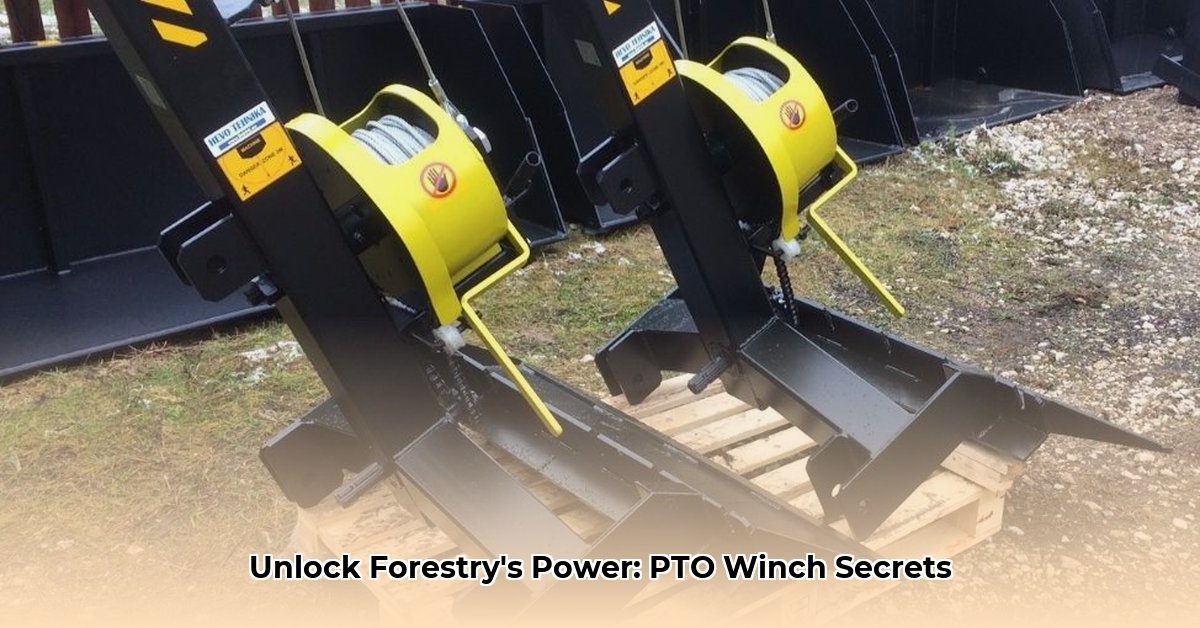
PTO Tractor Winches vs. Hydraulic Winches: A Comparative Analysis
Choosing the right tractor winch is crucial for efficient and sustainable forestry. Two main types exist: PTO (power take-off) and hydraulic. Understanding their differences is the first step towards making an informed decision. For more detailed specifications, check out this helpful resource on PTO winches.
PTO Winches: These draw power directly from your tractor's power take-off shaft (PTO), offering a generally more affordable initial investment. They are often favored for lighter-duty logging and less challenging terrains. Maintenance tends to be more straightforward, focusing primarily on cable and shaft inspection.
Hydraulic Winches: These utilize your tractor's hydraulic system. While typically more expensive initially, they often deliver greater pulling power and are often better suited for heavier-duty logging and more variable terrain conditions. However, maintenance can be more complex, involving the hydraulic system itself.
The following table summarizes key differences:
| Feature | PTO Tractor Winch | Hydraulic Winch |
|---|---|---|
| Power Source | Tractor's PTO shaft | Tractor's hydraulic system |
| Initial Cost | Generally lower | Generally higher |
| Maintenance | Simpler; primarily cable and shaft inspection | More complex; involves hydraulic system checks |
| Power Output | Dependent on tractor PTO horsepower | Dependent on tractor hydraulic pump capacity |
| Best Suited For | Lighter-duty logging, less challenging terrain | Heavy-duty logging, variable terrain |
Which type is right for your operation? Consider the scale of your logging projects and the terrain's challenges. A thorough assessment of your needs will guide your decision.
Selecting the Optimal PTO Tractor Winch: A Step-by-Step Guide
Choosing the right PTO winch requires careful consideration. Follow these steps for a successful implementation:
Assess Tractor Capabilities: Consult your tractor's manual to determine its PTO horsepower and capacity. Selecting a winch that exceeds your tractor's capabilities risks equipment damage and operational inefficiencies. Remember, underpowering is a recipe for disaster.
Analyze Terrain and Logging Activities: Challenging terrains (steep slopes, rough ground) necessitate winches with higher pulling power and robust construction. Similarly, the size and type of logs being handled impact the required winch capacity.
Develop a Realistic Budget: Consider not only the initial purchase price but also ongoing maintenance costs, cable replacements, and potential repairs. Investing in a high-quality winch that minimizes long-term expenses is a wise strategy.
Ensure Regulatory Compliance: Always check local regulations and safety standards concerning forestry equipment and environmental protection before making your purchase. Non-compliance can lead to significant penalties.
Safe Operation and Maintenance: Best Practices for Longevity and Safety
Safe and efficient winch operation is paramount. Neglecting safety procedures can lead to accidents, equipment damage, and environmental harm. Adhere to these best practices:
Secure Attachment: Always use the correct three-point hitch system for secure attachment to your tractor. Improper attachment compromises stability and increases the risk of accidents.
Controlled Winching: Avoid jerky movements. Smooth, controlled winching minimizes soil compaction and reduces the risk of equipment damage.
Regular Inspections: Regularly inspect the winch cable for fraying, kinks, or damage. Replace damaged cables immediately. Lubricate moving parts as recommended in the owner's manual.
Troubleshooting: Address unusual noises or vibrations promptly. If problems arise, consult your owner's manual or a qualified mechanic before continuing operation. A proactive approach prevents costly breakdowns.
Minimizing Environmental Impact: Sustainable Forestry Practices
Sustainable forestry demands minimizing environmental impact. Soil compaction is a significant concern when using tractor winches. Employ these strategies:
Strategic Winch Placement: Avoid repeatedly winching from the same location. Spread your work area to distribute the load and reduce localized compaction.
Ground Condition Awareness: Avoid using winches in excessively soft or wet soil. Such conditions heighten the risk of significant soil compaction and damage.
Alternative Harvesting Methods: In environmentally sensitive areas, consider alternative methods like using horses or smaller, tracked machines that cause less ground disturbance.
Ongoing Research: Stay informed about advancements in sustainable forestry practices and technologies aimed at reducing soil compaction. Continuous learning is crucial for responsible forest management.
Conclusion: Investing in Sustainable Forestry Practices
PTO tractor winches, when used correctly, dramatically boost productivity while minimizing environmental impact. By following this guide's recommendations for selection, operation, and maintenance, you'll maximize the benefits of integrating this technology into your forestry operations. Remember, continued learning and adaptation to new research will ensure you remain at the forefront of sustainable forestry practices. Invest in the future of your business and the health of our forests.